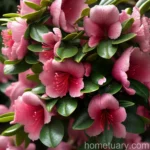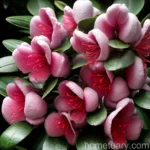Deciduous Azalea (Rhododendron atlanticum): A Guide to Cultivation, Care, and Maintenance

Introduction
Deciduous azalea, scientifically known as Rhododendron atlanticum, is a beautiful and vibrant flowering plant native to the Atlantic coastal plain of the United States. This stunning shrub is a popular choice for gardens and landscapes due to its captivating clusters of delicate, fragrant blossoms and attractive foliage.
In this comprehensive guide, we will delve into the characteristics, culture, cultivation, and maintenance of the deciduous azalea (Rhododendron atlanticum). Whether you are a seasoned gardener or just starting out, this article will equip you with the knowledge and insights needed to successfully grow and care for this enchanting plant.
What is Deciduous Azalea (Rhododendron atlanticum)?
Deciduous azalea, part of the Rhododendron genus, is a deciduous shrub that belongs to the Ericaceae family. It is native to the southeastern United States, particularly the coastal plains of Georgia and North Carolina. This species is commonly known as the coastal azalea or dwarf azalea.
Key Takeaways
Deciduous Azalea (Rhododendron atlanticum)
- Deciduous Azalea Species: A species of azalea native to the Atlantic coastal region of the United States.
- Rhododendron atlanticum Characteristics: Known for its fragrant, tubular flowers and deciduous nature.
- Atlantic Azalea Plant: Thrives in acidic, well-draining soils and is prized for its spring bloom display.
- Rhododendron atlanticum Care: Requires ample moisture, filtered sunlight, and periodic fertilizer application.
- Deciduous Azalea Varieties: Varieties exist in different colors, with shades of white, pink, and lavender.
- Azaleas in the Atlantic Region: Adaptable to the coastal climate and find natural habitat in the region’s woodlands.
- Rhododendron atlanticum Habitat: Typically found in moist, shaded environments near streams or swamps.
- Growing Deciduous Azaleas: Growth rate is moderate, and proper care is essential for optimal development.
- Rhododendron atlanticum Blooming: Flowers bloom in late spring, attracting pollinators such as bees and butterflies.
- Atlantic Azalea Garden: Complements woodland and shaded gardens, adding a burst of color and fragrance.
- Best Conditions for Rhododendron atlanticum: Flourishes in well-drained, acidic soils with partial shade and high humidity.
- Rhododendron atlanticum Pruning: Pruning after flowering encourages bushy growth and enhances next year’s blooms.
- Deciduous Azalea Colors: Displays an array of colors, contributing to its ornamental value in landscapes.
- Atlantic Azalea Landscape Design: A versatile plant for various landscaping styles and themes.
Now, let’s explore the cultural requirements, uses, and care tips for the deciduous azalea.
Culture
Uses
The deciduous azalea (Rhododendron atlanticum) is highly valued for its ornamental and ecological significance. Some of its primary uses include:
- Ornamental Plant: Its showy blooms and striking foliage make it a sought-after choice for gardens, parks, and naturalistic landscapes.
- Wildlife Habitat: Provides nectar and pollen for pollinators, attracts hummingbirds, and supports biodiversity.
- Erosion Control: Contributes to stabilizing soil along water bodies due to its fibrous root system.
Water
Adequate moisture is crucial for the health and vigor of deciduous azaleas. Here are some water-related considerations:
- Watering Frequency: During dry periods, water the plant deeply at least once a week, aiming for a total of 1 inch of water.
- Drought-Tolerance: While mature plants are somewhat tolerant of short dry spells, consistent moisture is preferred, especially during the flowering and growth periods.
- Avoid Waterlogging: Ensure good drainage to prevent waterlogged soil, which can lead to root rot and other problems.
Sunlight
Deciduous azaleas have specific sunlight requirements that impact their growth and flowering. Consider the following:
- Partial Shade: Thrives in dappled or filtered sunlight, particularly in the morning and late afternoon.
- Morning Sun: Protection from intense midday sun is beneficial, as it can cause leaf scorch and reduce flower longevity.
- Woodland Settings: Ideal in shaded gardens, under the canopy of trees, where they receive gentle sunlight and dappled shade.
Fertilizer
Fertilization plays a crucial role in promoting healthy growth and abundant blooms. Follow these guidelines for fertilizing deciduous azaleas:
- Acidic Fertilizer: Apply a balanced, slow-release fertilizer formulated for acid-loving plants in early spring before new growth emerges.
- Frequency: For established plants, feed once a year in spring. Newly planted azaleas benefit from a light application three to four weeks after planting.
- Avoid Overfertilizing: Excessive fertilization can lead to excessive foliage growth at the expense of flowers and may also harm the plant.
Soil
The soil quality directly impacts the overall health and performance of deciduous azaleas. Consider the following soil requirements:
- Acidic Soil: Requires well-draining, acidic soils with a pH level between 4.5 to 6.0. Amending with organic matter can improve soil structure and acidity.
- Moisture Retention: Ensure the soil retains moisture without becoming waterlogged to support the plant’s water needs.
- Mulching: Mulch with organic materials, such as pine bark, to conserve soil moisture, suppress weed growth, and maintain cool root temperatures.
Pruning
Pruning is an essential aspect of maintaining the shape, size, and flowering potential of deciduous azaleas. Follow these tips for effective pruning:
- Post-Blooming Pruning: Perform light pruning immediately after the flowering period to maintain a compact and bushy growth habit.
- Remove Deadwood: Regularly remove dead, damaged, or diseased branches to enhance air circulation and overall plant health.
- Old Wood Pruning: Once established, older plants benefit from occasional rejuvenation pruning to stimulate new growth and improve overall vigor.
Propagation
Propagating deciduous azaleas can be achieved through various methods, including:
- Softwood Cuttings: Collect softwood cuttings in early summer and root them in a well-draining, moist medium, such as perlite or sand.
- Layering: Encourage new root formation by layering a low branch of the plant, allowing it to root while still attached to the parent plant.
- Seeds: Harvest seeds from mature seed capsules in the fall, sow them in a suitable seed-starting mix, and provide the necessary conditions for germination.
Container Popularity
Deciduous azaleas are well-suited for container cultivation, offering versatile and aesthetic options for outdoor and indoor gardens. Consider the following container-related aspects:
- Size Selection: Choose a container that accommodates the plant’s current size, with additional space for root expansion.
- Drainage: Ensure the container has sufficient drainage holes to prevent waterlogging and root rot.
- Potting Mix: Use a well-draining, acidic potting mix specifically formulated for azaleas and other acid-loving plants.
- Outdoor Placement: Position containers in partial shade and provide regular watering and fertilization for optimal growth and flowering.
Common Diseases
Deciduous azaleas are susceptible to certain diseases, particularly in conditions that are unfavorable to their growth. Common diseases include:
- Powdery Mildew: Appears as a white, powdery coating on leaves, typically in humid conditions. It can weaken the plant and reduce its ornamental appeal.
- Leaf Spot: Characterized by dark spots on leaves, often caused by fungal pathogens. Proper sanitation and good air circulation can help prevent its occurrence.
- Root Rot: Resulting from waterlogged soil conditions, root rot can lead to wilting, decline, and ultimately, the death of the plant if left untreated.
Disease Diagnosis
Diagnosing diseases in deciduous azaleas involves careful observation of symptoms and prompt intervention. Consider the following diagnostic steps:
- Symptom Identification: Identify the specific symptoms, such as leaf discoloration, wilting, or unusual growth patterns.
- Visual Inspection: Check for signs of fungal growth, lesions, or any visible changes in plant tissue.
- Professional Consultation: Seek guidance from horticulturists or plant pathology experts for accurate diagnosis and treatment recommendations.
Common Pests
Several pests can affect the health and appearance of deciduous azaleas, including:
- Azalea Lace Bug: Feeds on plant sap, causing stippled or bleached foliage and generally weakening the plant. Regular monitoring can help control their population.
- Spider Mites: Small, sap-sucking pests that may cause leaf discoloration and reduced plant vigor. Spraying with water or introducing natural predators can help manage infestations.
- Caterpillars: Certain caterpillar species can defoliate the plants if left unchecked. Handpick or use biological control agents to manage caterpillar populations.
Botanist’s Tips
Cultivating and caring for deciduous azaleas requires thoughtful attention to their specific needs and preferences. Consider the following botanist’s tips for successful azalea cultivation:
- Soil Testing: Regularly test soil pH and nutrient levels to ensure the growing medium meets the plant’s requirements.
- Disease Prevention: Practice good sanitation and proper spacing to reduce the risk of disease incidence and spread.
- Native Planting: Incorporate deciduous azaleas in native plant gardens and landscapes to support local ecosystems and wildlife.
- Pollinator Support: Encourage pollinator activity by planting companion plants that attract and support bees, butterflies, and hummingbirds.
Fun Facts
Before we conclude, let’s explore some intriguing and noteworthy facts about deciduous azaleas:
- Fragrant Blooms: The flowers of deciduous azaleas exude a delightful fragrance, attracting pollinators and enchanting garden visitors.
- Fall Foliage: In addition to their spring blooms, deciduous azaleas also offer striking fall foliage, adding to their seasonal appeal.
- Habitat Value: In their natural habitat, deciduous azaleas provide critical resources for native fauna and contribute to the ecological balance of their ecosystems.
Links to External Resources
To further enrich your knowledge of deciduous azaleas, consider exploring the following external resources:
- American Rhododendron Society
- United States Department of Agriculture (USDA) Plant Database
- North Carolina State University – Extension Gardener Handbook
- The Azalea Society of America
- The North Carolina Arboretum
In conclusion, the deciduous azalea (Rhododendron atlanticum) is a charming and versatile plant that enriches landscapes with its vibrant blooms and alluring fragrance. By understanding and meeting its cultural requirements, ensuring proper care, and managing potential challenges, you can successfully cultivate and enjoy the beauty of this remarkable species in your gardens and natural spaces. Happy gardening!















